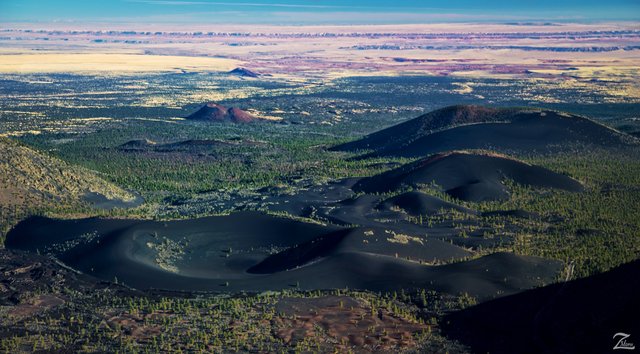Some Volcanoes are Simply Asleep for the Moment!
Sunset Crater near Flagstaff is only 932 years old, it has barely fallen asleep in geologic time.
And though only a relatively small volcano when it erupted, there were First Nations Sinagua Tribes living around the San Francisco Mountains close by. So humans experienced this event!
Sunset Crater Volcano National Monument contains the results of much igneous activity - several colorful cinder cones formed by extinct volcanoes, and large expanses of lava and ash, mostly unobscured by vegetation and still pure black in color.
The dominant peak is Sunset Crater; as with the other cones its slopes have distinctive dusky red-brown patches formed by oxidised iron and sulphur, which caused John Wesley Powell, who was the first modern-day explorer of the area in 1887, to name the mountain 'Sunset Peak'.
The contrasting colors of the cinders provide the most unusual aspect of the national monument but the jagged and twisted lava fields are also quite spectacular. Sunset and the neighboring craters are just one small part of the San Francisco volcanic field, an extensive region of nearly 2,000 square miles that contains some 600 identified volcanoes. (Research Source)
The volcanic eruption produced a blanket of ash and lapilli covering an area of more than 2,100 square kilometers (810 sq mi) and forced the temporary abandonment of settlements of the local Sinagua. (Research Source)
I am flying to the north of the Sunset Crater National Monument when I lensed this image. In the immediate foreground lies the Bonita Lava Flow. This is lava that broke out the side of the cinder cone formed structurally complex flows some nearly two miles in length composed of basalt.
Flows typically start as pahoehoe, thin and runny, forming a smooth ropy texture when cooled. As the lava cools and becomes thicker it changes into an Aa flow. Aa flows are characterized by their jagged, blocky texture. The majority of the lava here is Aa lava. (Research Source)
The Bonito Lava flow ranges in thickness from 5 feet at the edge to over 100 feet in the center. As this lava flowed out from the base of Sunset Crater Volcano (in the near distance), it had a lot of gas still dissolved in it. As the gas came out of solution, just like the carbon dioxide in carbonated drinks, it formed bubbles in the lava.
Some of these bubbles were frozen in the lava in what are called vesicles (if you look closely at the immediate foreground deposits you can see these). Most of the vesicles are small, but sometimes, the gas accumulates under outer surface of the flow that has cooled forming large vesicles. (Research Source)
In the distance just below the horizon you can see the jagged cliffs of Walnut Canyon National Monument where there are 25 cliff dwelling rooms constructed by the Sinagua, the very people that had to temporarily leave the area when this volcanic eruption occurred.
This image is from my ongoing project in which I am trying to raise awareness of the 47% of the USA and 90% of Canada that remain unpopulated wilderness.
Where Eagles Fly - The American Wilderness Expedition is my personal mission to introduce people to these amazing locations that surround us.
If you like what you see here upvote then resteemit so that others may experience these wondrous places as well.
Yehaw!!

Good work...keep going....upvoted... mate can u plz check my art post for your support..
very great post!
wow what an amazing place - awesome crater. You really get to see everything up in the air! Such a great existence!
Hey Thanks SallyBeth! I love my life!!!! I love doing this and I really love sharing this with everyone!! yehaw!!
An amazing photo. That is one very large volcanic field! Lots of interesting information. Thanks for sharing. I learned something today about lava flows.
Thanks and yehaw!!
Wow amazing